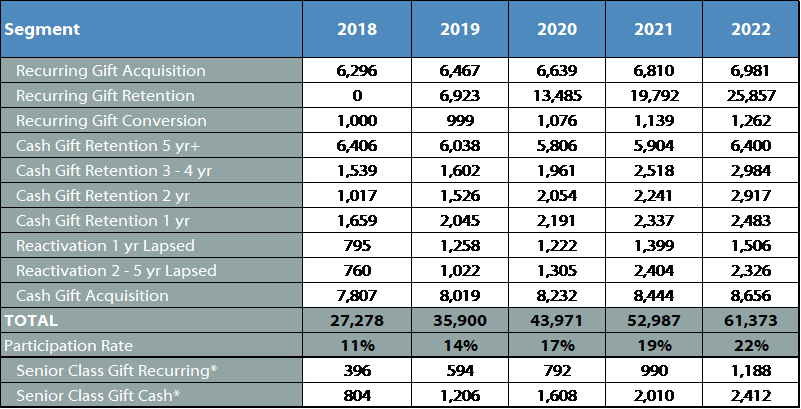by Adrian Salmon
In 2016, President Tim Sands of Virginia Tech set a goal to increase alumni giving from 9% participation to 22% by 2022, the University’s 150th anniversary. The effort was intended to reverse a ten-year downward trend in alumni participation, a challenge that has been experienced by countless colleges and universities nationwide, as reported to the Council for Aid to Education (CAE).
In one fiscal year’s time, the team at Virginia Tech achieved a whopping 53.42% retention among first time donors—nearly double the industry standard. They also raised the overall alumni participation rate by 37%—from 9% to 12.29%. How did they achieve such impressive results?
The Process
GG+A began working with Virginia Tech on an annual giving-specific approach in the summer of 2017. We examined their annual giving program at both the macro and micro levels. At the macro level, we looked at giving trends and patterns by different alumni constituencies, and at the micro level, we analyzed each individual household’s past giving and demographics. We used this information to develop a five year plan to move the university’s alumni participation above 30%. Importantly, the plan incorporated anticipated growth in alumni class size, which was expected to increase from 171,203 in 2018 to 183,866 in 2022.
In the household-level analysis, GG+A found that certain demographic indicators correlated strongly to annual giving participation regardless of their alumni constituency group. GG+A coded these records with a Propensity Rating, modeling all records with common variables into different bands.
| Propensity Rating | |
| P1 |
Most Likely |
| P2 | ↓ |
| P3 | ↓ |
| P4 | ↓ |
| P5 | ↓ |
| P6 | ↓ |
| P7 | |
GG+A more heavily weighted participation among the top performing bands (P1-P4) than lower rated bands (P5-P7 and unrated) in the plan. Using these ratings, as well as a sustainer giving model, GG+A developed a multi-channel approach with an emphasis on donor retention alongside overall participation.
GG+A Plan for Virginia Tech by Past Giving Behavior
GG+A Plan for Virginia Tech by Year and Giving Behavior

Following the delivery of our report and action plan, GG+A Vice President Adrian Salmon worked alongside a multidisciplinary Virginia Tech team convened by John Torget, Assistant Vice President for Leadership Gifts and Annual Giving. Salmon provided ongoing strategic counsel on best practices in sustainer giving, telephone fundraising, digital and direct mail, and donor retention with the aim of creating a loyalty-focused cadence of communications and solicitations. GG+A’s Survey Lab provided invaluable insights into the kinds of messaging and giving opportunities that would resonate for Virginia Tech’s alumni. As Torget described the situation, “We needed a bridge from President Sands’s audacious and aspirational goal to a true all-advancement implementation plan. GG+A provided key data-driven insights, an actionable plan, the sense of urgency needed for relentless focus on year-one results, and the coaching to get there.”
The Outcome
Between July 2017 and June 2018, Virginia Tech had a 53.42% retention among first time donors. They increased the academic annual fund revenue by 20% and overall annual fund revenue, including athletics, by 8%. Finally, they achieved a mammoth 95.7% retention rate for alumni who have donated for the last five or more consecutive years and re-activated 31.66% of households who had donated in 2016 but not in 2017. Between these impressive retention and revenue results and the increase in alumni participation to 12.29%, Virginia Tech is well on its way to meeting President Sands’ 2016 challenge. GG+A looks forward to partnering with them in continued success.


